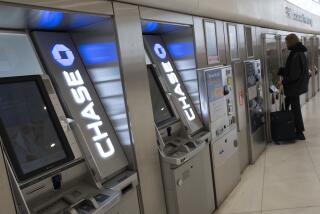B of A Moves to Settle Suit Over Bounced-Check Fees
Bank of America, moving to settle a class-action suit alleging that it overcharged customers in fees for bounced checks, agreed Friday to provide $2.5 million for consumer education, $10 million for low-income housing and $25 in free banking services to each of more than 10 million present and former California customers.
The settlement, apparently the largest of its kind in history, was hailed as “creative” and “far-reaching” by attorneys for both the bank and the class, which consists of Bank of America checking account customers going back to 1973.
But other public-interest lawyers familiar with the case called the settlement “cynical” and said it provides only “illusory” benefits to bank customers. The proposed settlement must be approved by the Superior Court in San Francisco.
The class-action lawsuit was filed in 1977 on behalf of San Francisco musician Peter G. Rudolfi after he got fed up with paying Bank of America $4 every time he wrote a check with insufficient funds in his account. Ironically, the bank has since raised its fee for bounced checks to $10--a level sanctioned by the proposed settlement.
“This is a historic settlement that provides a multitude of benefits for bank customers, past and present, and for society as a whole,” said David B. Baum, a lawyer for the plaintiffs. “For a public-interest lawyer, this is a dream come true,” added Sidney M. Wolinsky, who also worked on the plaintiffs’ case.
Bank of America has agreed to pay the lawyers who filed the lawsuit up to $1.4 million in fees and $77,000 in costs. The exact amount will be determined by an arbitrator.
Bank of America Vice Chairman Richard Rosenberg said the settlement “puts an end to costly litigation on terms that provide a great deal of lasting value to our customers . . . at an appropriate cost to the bank.”
The settlement contains several novel features. These include establishment of a $2.5-million consumer education fund to be administered by an independent foundation and the provision of $10 million in interest-free loans over two years to spur the creation of low-income housing.
$25 Certificates
The bank will also distribute certificates for $25 worth of free banking services to 10 million former customers, and to those of Bank of America’s 2.8 million current customers who lack overdraft protection on their checking accounts.
Critics of the settlement contend that the $25 certificate is little more than a marketing ploy by the bank. Bank spokesman Peter Magnani acknowledged that “in the case of former customers who take advantage of the certificate, we will get a new banking relationship.”
Magnani played down the cost of the settlement to the bank. “The value to members of the class far exceeds the cost to us,” he said. The certificates can be redeemed to pay for money order fees, cashier’s check fees, checking account charges, credit card membership charges, safe deposit rental fees and other bank charges.
The suit is one of 25 filed against California banks since the mid-1970s. The suits originally were intended to wrench hundreds of millions from banks and force them to slash bounced-check and other charges to consumers. Today, however, as the cases are settled, attorneys who have been involved in them are mired in infighting over terms of the settlement and attorneys’ fees.
The first settlement, similar in some respects to the proposed Bank of America deal, came in a suit against Wells Fargo and Crocker National a year ago. More than a dozen lawyers continue to haggle over how to split $3.4 million in attorneys’ fees.
Baum, who with Wolinsky handled the bulk of the Wells Fargo case, has estimated in the past that the settlement could be worth more than $100 million to consumers, if everyone eligible took advantage of Wells’ offer of a no-fee credit card for one year plus other aspects of the settlement.
Disagreement on Value
But critics maintain that it is worth no more than $10 million because relatively few will do so and that it may even benefit the bank by bringing in new customers. The case should have brought tens and possibly hundreds of millions of dollars to banking customers, the critics contend.
“This was supposed to help consumers. Instead, it has turned into a fight among lawyers and that is unfortunate,” attorney Stephen Kaus, a critic of the settlements, said of the cases.
In one of the more startling instances of the rancor, consumer advocate Ralph Nader and Ralph Abascal, the named plaintiff in the Wells Fargo case and general counsel of California Rural Legal Assistance, took out large ads in newspapers to declare of the Wells Fargo deal: “The banks get off, the lawyers get rich and you get zilch.”
The bank charge cases began as the brainchild of Abascal’s brother, Manuel, then a law student who had had a run of bounced checks and went to work for Baum and his then-partner, E. Robert Wallach.
With the cases still in their infancy, Abascal had a falling out with Wallach and Baum. Other attorneys also split with Wallach and Baum and brought other suits against a number of banks. A court order placed the secondary suits on hold while Baum, Wallach and Wolinsky pursued the original cases.
The critics fought to have the Wells Fargo settlement overturned, but it has been largely upheld by a Superior Court judge. Still, they are considering a similar challenge to the Bank of America settlement.
“It’s illusory to the class,” Manuel Abascal, now a Berkeley lawyer, said of the Bank of America settlement. If approved, the deal will preclude Bank of America customers from getting “fair fees for bank services, and prevent them from recovering literally hundreds of millions of dollars in excessive charges.”
‘It Is Cynical’
“This is merely the next step in the program of class counsel to capture benefits for themselves in disregard to customers. . . . It is cynical; it is most cynical.”
Kaus said settlement terms that provide for funds for public education and low-income housing loans “sound encouraging” but added, “Obviously, this is an attempt to put the best face on the deal.”
Also, he noted that the $2.5 million for consumer education will be provided over a 10-year period--with the bulk of the funds coming at the end of the period--and thus is worth far less in terms of present value.
Plaintiffs’ lawyer Wolinsky said, “It doesn’t surprise me that they would attack it without knowing what it’s about.” He called it “one of the best settlements I have ever seen,” adding that the $10 million for low-income housing will translate into “$100 million” in construction by mixing it with other financing and taking advantage of the zero-interest rate that is part of the deal.
“It’s the easiest thing in the world to Monday morning (quarterback) somebody else’s deal,” Wolinsky said.






